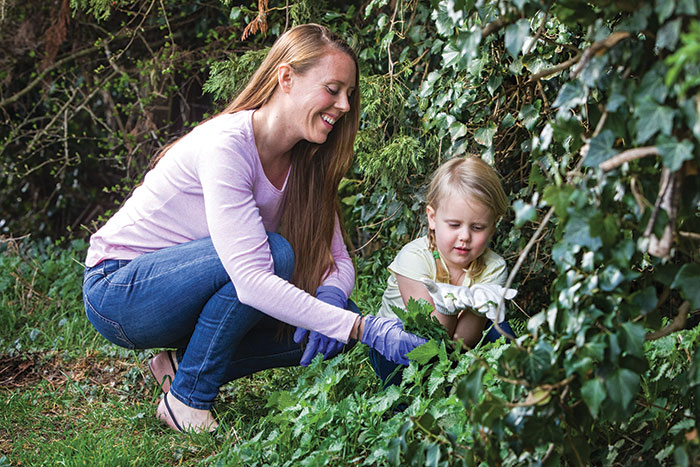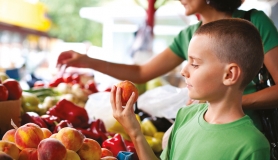The average household spends £100 a week on groceries. This may seem a reasonable amount, but recent government figures show that food waste is on the increase, with a family of four throwing away £60 worth of edible food every month. That equates to a whopping 7 million tonnes of wasted food and drink from UK homes every year!
Until recently our family was no different. Forgotten leftovers and jars past their sell-by-date would end up in the bin, whilst mouldy bread and biscuits were frequently fed to the ducks. We threw away the contents of two food waste bins every week as well as filling one blue recycling bin a fortnight, and never gave too much thought to the amount of rubbish we produced.
But in January 2015, inspired by Jack Monroe and Jamie Oliver, the pioneers of eating on a budget, I decided to see if I could put a stop to this waste and embarked on a journey to feed our family for just £100 a month. However, instead of using Supermarket basics ranges, the goal was to support the community and shop locally.
It was a daunting task, one that I wasn’t sure we would achieve. I reminded myself that many people around the world have to feed their family on a pittance. I concluded that this challenge would be good for us; helping us rein in our purses and waistbands after the indulgent festive period.
SHOPPING LOCAL
My first outing was to a local Farmers Market with all the hope of the New Year. However, after a few minutes I realised I was going to have to turn my back on beautiful joints of beef, speciality cheeses and glorious pies, and left with a large Savoy cabbage costing just £1. This was going to be tougher than anticipated.
My next task was to sign up to various local vegetable box delivery schemes, trialling a different one each week. It was a joy to see the vegetables covered in soil rather than Supermarket cellophane. You could feel the vibrancy and freshness of the produce, something that’s often missing when the food has been sitting on plane followed by a supermarket shelf for weeks before arriving on your plate.
I devised meal plans based around the contents of the veggie box, and bought local meat, fish, eggs and grains to complement each meal. No food was to be wasted.
STRUGGLING TO FIT IT IN
After the first week I had spent a massive £44 of our budget and was very disheartened. All the sourcing produce, cooking and writing up the blog had left me completely exhausted! It had become a full time job. Could I ever hope to achieve our aim?
The second week saw an improvement. During my research I had stumbled across farm eggs for just 84p a half dozen. I discovered a pick-your-own that sold a 25kg sack of potatoes for £7 and a butcher that stocked local meat cheaper than the supermarkets.
I was introduced to a whole food supplier that sold dried goods such as oats, rice, beans and nuts by weight at bulk buy prices. I learned to soak and sprout my own dried pulses and then kicked myself for having spent so much money on tinned chickpeas over the years.
We foraged for nettles and made pesto, which was just as delicious and nutritious as basil. We picked fresh dandelion leaves to make a salad which was absolutely free.
MAKING USE OF EVERYTHING
After the second week I’d had a complete change in attitude. It was no longer a chore or a sacrifice, but a challenge. Every ounce of food mattered. I began scrubbing our fruit and vegetables instead of peeling. After all, most of the nutrients lie just under the skin, and when eating organic you’ve no need to worry about nasty chemicals. When I did peel to make mash, I baked the discarded potato peelings in olive oil and ate them like crisps.
I made a ‘food waste’ soup using chicken bone broth, garlic and onion skins, with leftover vegetable stems, that was simply delicious. I even saved up a week’s worth of orange and lemon peel, boiled and blitzed them to a pulp before adding them to a zesty Victoria sponge cake mix that would give Nigella a run for her money. One valuable lesson I learned was to improvise and manage simply with whatever I had available. When we invited guests over for tea, short on butter, I used the flesh of a roasted pumpkin to create beautifully moist chocolate brownies. I discovered that a few drops of beetroot juice turns icing bright pink, and that leftover porridge makes delicious oatmeal biscuits. I even learned that I could crush organic eggshells to make bio-available calcium!
EXPANDING INTO COMMUNITY
By the fourth week our stocks were running low, so we put in a few hours labour on a local Cultivation project and got to take home some of the harvest. I also stumbled on a Monday Shop that sells leftover Market fruit and vegetables that would usually end up in the bin for a small donation. We even met a remarkable group of people who are exercising their commoners’ rights by grazing cattle on village land in order to get cheap local organic beef just metres from where they live.
I realised how selective and wasteful my family had been before starting out on this project. My daughter, who had been picky, was now eating better than ever. We had finally learnt to value every morsel. Some of our favourite meals were good old British Classics such as Bubble and Squeak with a freshly poached egg and roast chicken, seasonal vegetables and homemade gravy.
Cooking meals from scratch meant that none of the food we ate was processed. We consumed less meat and cut right back on refined grains and sugar. By the end of January, we had all lost the Christmas bulge and had a spring in our step.
At the end of the month our bill came in at just a few pounds over budget. However, the benefits we experienced far outweighed any financial payoff. We supported our local community which gave us a sense of belonging. We ate local seasonal produce and learned that foraging and cooking from scratch is a great way to really reconnect with food and the environment.
On top of the many health benefits, knowing the source of each ingredient gave us a very satisfying feeling. As a result, we haven’t looked back and continue to aim to feed the family for just £100 a month. We are still stumbling upon more amazing local produce, and are very much looking forward to the summer, when British produce really comes into its own. Our new motto is you don’t have to be wealthy to be healthy!
Caroline shares some of the trusty, tasty and nutritious recipes that she used to keep to her budget
LEFTOVER PORRIDGE OATMEAL AND RAISIN BISCUITS
One morning, my daughter Melissa refused her porridge. I couldn’t bear to throw it out, so decided to turn it into oatmeal and raisin biscuits and cunningly feed it back to her later in the day. She never even noticed, and was thrilled with the home made after school snack. My recipe is not exact, but it really doesn’t need to be to create really tasty biscuits.
• Approximately 1 cup of leftover porridge
• 125g of flour
• 1 egg
• 3 tbsp of brown sugar
• 1 tbsp of butter
• 1 generous handful of raisins
Preheat the oven to gas mark 5 /190 C. In a bowl, mix all the ingredients together. The dough should be sticky but not overly wet. You should be able to form it into a large ball with your hands. If needed, you can always add more or less flour, or a tablespoon of milk to obtain the right texture. Now form the dough into 10 small rounds and place them on a tray lined with baking paper. Squash them down a little to make rustic biscuit shapes. Bake the biscuits for 20 minutes until golden brown. They’re delicious and no-one need know they’re breakfast leftovers!
STINGING NETTLE PESTO
Cooked nettles have a very similar taste and vitamin content to spinach, but as they grow in the wild they are absolutely free. When foraging for nettles, make sure you wear thick gardening gloves and pick from an area far away from the pollution of a busy road. Choose just the young leaves from the top of the plant.
• 100g young nettles
• 1 crushed garlic clove
• 75g strong cheddar, grated
• 50g cashew nuts
• Juice of half a lemon
• 1 tbsp of natural yoghurt or olive oil
Wash the nettles and discard any thick stalks. In a pan gently fry a crushed clove of garlic until golden brown. Add the rinsed nettles and a tbsp of water to the garlic and cook for a couple of minutes until the leaves have wilted. Switch off the heat. Transfer to a food processor or hand blender to blend the nettles. Add the grated cheese, cashew nuts, lemon juice and yoghurt and continue to blend until you have a smooth green paste. Add more yoghurt or olive oil if needed. Simply stir the nettle pesto through cooked pasta, season with black pepper and serve with fresh salad leaves. The pesto will keep in an airtight jar in the fridge for up to a week.
Caroline is a mum, nutritionist, herbalist and parenting blogger from Oxford. She is interested in anything to do with good food and foraging, natural health and holistic parenting. Read her at mydaughterwontsleep.com
Photography Mark Basset
MORE INSPIRATION
READ Caroline’s family cooking blog at feedafamily.co.uk
COOK More of these great frugal recipes can be found at thegreenparent.co.uk/articles/category/food
LEARN Caroline is giving a talk on feeding a family on £100 a month at Be Well London feedafamily.co.uk/talk







